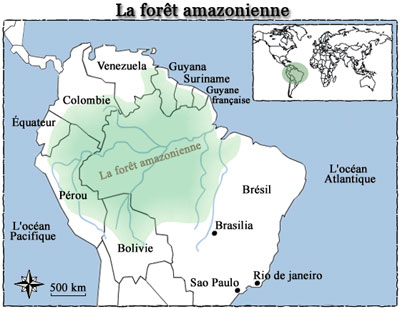 What is a forest?
What is a forest?
Forests are lands spanning more than 0.5ha, with trees higher than 5m and a canopy cover of more than 10%, excluding land that is predominantly under agricultural or urban land use (FAO). Therefore, fruit trees or palm oil tree plantations are not considered as forests.
Forests cover 31% of global land surface and house a very important biodiversity. A third of forests are primary forests where there are no clearly visible indications of human activities and the ecological processes are not significantly disturbed.
Worldwide, there are five types of forests: boreal, polar, temperate, subtropical and tropical (with the Amazon and a mosaic of various forests). The largest part of the forest (45%) is found in the tropics.
Global forest area by climatic domain
For more information: The State of the World’s Forests 2020. Forests, biodiversity and people. FAO & PNUE.
 The Role of Forests
The Role of Forests
Forests have a key role in the conservation of social and ecological balances. They provide a wide range of services:
Nowadays, almost 1.6 billion people depend on forests for their survival.
Forests disappear among other reasons because their value is under-estimated and our market economy can’t recognize the ecosystem services they provide.
 Deforestation
Deforestation
World forests are in danger. Each year it’s the equivalent of Greece surface that disappears.
Deforestation means less trees to capture CO2 but also to boost evapotranspiration, which affects rainfall patterns, increases drought and fosters wildfires…which are in turn responsible for CO2 increase by freeing up carbon contained in soils. A catastrophic scenario that plays over and over and ever faster with climate change.
To get more information:

![[CCYM]Cime_Jan2018@L.MOREY](http://da1323dc.delivery.rocketcdn.me/wp-content/plugins/revslider-disabled/public/assets/assets/dummy.png)
![[SEPAZ]ceiba3_∏L.Durant](https://da1323dc.delivery.rocketcdn.me/wp-content/uploads/2020/09/SEPAZceiba3_∏L.Durant.jpg)


![[ProgTARN]PLantation hiver1_2019∏EV](https://da1323dc.delivery.rocketcdn.me/wp-content/uploads/2020/09/ProgTARNPLantation-hiver1_2019∏EV.jpg)
![[AGROFO_CafÇ]germination1∏L.Durant](https://da1323dc.delivery.rocketcdn.me/wp-content/uploads/2020/09/AGROFO_CafÇgermination1∏L.Durant.jpg)